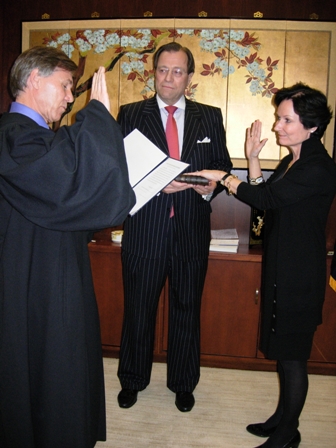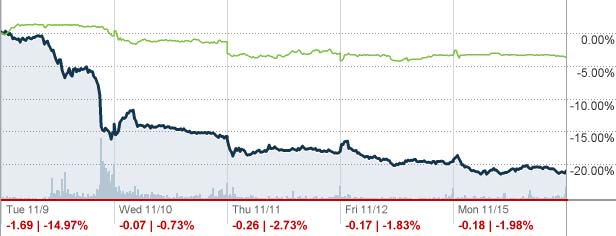Professor Hal Wegner has noted in his daily listserv that Judge Kathleen O’Malley has now been sworn-in as a Circuit Judge on the US Court of Appeals for the Federal Circuit. You can read more about the swearing-in ceremony on the Federal Circuit web site [Link].
Archive for the ‘Uncategorized’ Category
Circuit Judge O’Malley Sworn-In
Tuesday, December 28th, 2010Citation to Wikipedia Articles by Trademark Office
Thursday, December 23rd, 2010You know what “PHONECASTING” is don’t you? I have to admit that I didn’t have a clue what “PHONECASTING” was until I listened to the oral argument of In re Sharp. Never having heard of the term before, I was surprised that it had been determined to be a generic term by the TTAB. The Federal Circuit affirmed that decision.
The oral argument discusses whether PHONECASTING is generic or merely descriptive. It is interesting in that it discusses the fact that the TTAB relied upon WIKIPEDIA entries and the applicant’s own PCT patent application that defined PHONECASTING, among other evidence.
You can listen to the oral argument here: [Listen]. The discussion of the Wikipedia articles takes place at about the 17:30 and 24:30 minute marks in the oral argument.
The TTAB opinions are available [here] and [here].
The Federal Circuit Rule 36 affirmance is available here: [Read].
US District Court Patent Pilot Program
Friday, December 17th, 2010The House of Representatives passed the bill for the US District Court Patent Pilot program today by a vote of 371-1. The bill was previously passed by the Senate. Here are some of the comments by members of the House:
President Obama on Patenting
Friday, December 17th, 2010President Obama spoke at Winston-Salem, North Carolina earlier this month where he noted that the US should make it easier to patent a new idea or a new invention.
Order to Show Cause
Saturday, December 11th, 2010A few weeks ago, I noted that Judge Dyk had commented that the improper use of “Confidential” markings in appeal briefs was an “absolute plague.” [Link].
I ran across another oral argument from the last few years where Judge Dyk actually issued an order to show cause as to why the party that improperly marked material as confidential should not be sanctioned. [Listen] and [Listen]. The confidential markings had been applied to case citations and quotations in a brief.
Research Corp. Technologies, Inc. v. Microsoft Corp.
Wednesday, December 8th, 2010The Federal Circuit issued an important decision concerning “abstract ideas” and 35 USC §101 today in Research Corp. Technologies, Inc. v. Microsoft Corp., 2010-1037 (Fed. Cir. Dec. 8, 2010).
If you are interested in listening to the oral argument from the case, it is available here: [Listen].
The court’s opinion is available here: [Read].
When the seas change
Tuesday, November 30th, 2010There is an interesting sound bite from back in 2007 during the oral argument of Maurice Mitchell Innovations, L.P. v. Intel Corp., 2007-1108 (Fed. Cir. Sept. 24, 2007). The patent at issue had been filed in 1987 and had been written with extensive “means” language. Fast forward twenty years to 2007 with the claim language under review by the Federal Circuit, Judge Rader inquired of counsel to what extent the evolution of the law surrounding “means plus function” claims should be taken into account: [Listen].
The Federal Circuit opinion is available here: [Read].
To the extent that the treatment of “means plus function” claims was the sea change of the 90’s, I think one could argue that the treatment of office actions under Dayco and McKesson is the sea change of the twenty-first century. Hopefully, only a temporary rogue wave.
Supreme Court Review of i4i v. Microsoft
Monday, November 29th, 2010The Supreme Court has granted Microsoft’s petition for certiorari in the I4I v. Microsoft case. The Federal Circuit’s revised opinion is available here: [Read].
You can listen to the oral argument at the Federal Circuit below. The oral argument was over an hour; so, I’ve divided it into three segments (1) Microsoft’s argument; (2) i4i’s argument; and (3) Microsoft’s rebuttal argument.
Microsoft’s argument: [Listen]
i4i’s argument: [Listen]
Microsoft’s rebuttal argument: [Listen]
Supporting documents including briefs and a link to the patent can be found at I4I’s web site: [Link].
Be Prepared to Argue Your Co-Counsel’s Case
Sunday, November 28th, 2010When there are multiple defendants in a patent case, it is common during the appeal for each defendant’s attorney to argue a portion of the allotted time during oral argument. That rarely works well and the judges have been heard on more than one occassion to express their dissatisfaction with that arrangement.
At a recent oral argument, as the parties were just about to begin their oral arguments, the panel asked if the attorneys for the defendant-appellants wouldn’t mind rearranging their argument time. Instead of each attorney arguing the issues that affected his respective client, one attorney was asked to speak to all the issues in the opening argument. The other attorney was asked to handle the rebuttal argument on all issues. As you can hear Chief Judge Rader explain, this was to help the panel develop a more fluid line of questioning. [Listen]. The attorneys agreed to accommodate the court; and being very talented advocates, they conducted the oral argument without any hiccups.
One interesting note is that Chief Judge Rader commented that the court views oral argument as its time. That is probably a useful reminder for appellants.
Asking parties to switch or embrace unexpected issues at the last minute strikes me as a bit unfair. It raises interesting hypothetical ethical issues as well. One could imagine a hypothetical situation where defendant A has a strong non-infringement position and wouldn’t mind seeing its competitor, defendant B, found to have infringed the same patent under its weaker theory of non-infringement or invalidity defense. Nevertheless, attorney for party A is asked by the court at the last minute to present on all the issues, which necessarily requires defending party B.
You can listen to the entire oral argument here [Listen] and read the court’s Rule 36 opinion here: [Read].
Constructive Notice — Patent Marking
Monday, November 22nd, 2010In Nike, Inc. v. Wal-Mart Stores, Inc., 138 F. 3d 1437 (Fed. Cir. 1998), Judge Newman noted that “[i]n order to satisfy the constructive notice provision of the marking statute, Nike must have shown that substantially all of the Air Mada Mid shoes being distributed were marked, and that once marking was begun, the marking was substantially consistent and continuous.”
The Federal Circuit recently was presented with the issue of what does “substantially consistent and continuous” mean in the constructive notice context during the oral argument of Japan Cash Machine Co., Ltd. et al. v. MEI, Inc., 2010-1069 (Fed. Cir. Nov. 8, 2010). The panel issued a Rule 36 opinion; so, there is no additional guidance to be garnered from a written opinion. But, the oral argument is interesting as the panel tried to gain insight into what satisfies “substantially consistent and continuous.”
You can listen to the oral argument here: [Listen]. The discussion of marking begins at about the 17:45 minute mark.
You can see the court’s Rule 36 opinion here: [Read].
Citation of Material After Payment of Issue Fee
Thursday, November 18th, 2010One of the issues that came up in the appeal of Flexiteek Americas, Inc. et al. v. Plasdeck, Inc. et al., 2009-1501 (Fed. Cir. Nov. 2, 2010) was whether it was inequitable conduct for failure to cite to the US examiner the revocation of a related New Zealand patent. The status of the US application at the time of the revocation of the New Zealand patent was that the issue fee had been paid but that the patent had not yet issued. The person charged with inequitable conduct was president of a Swedish company. He apparently had an opinion from Swedish counsel that there was no way to have the new material considered since the issue fee had been paid.
You can listen to the panel question the counsel for the appellee-plantiff-patent owner here: [Listen].
The panel followed up on rebuttal with the counsel for the appellant-defendant here: [Listen].
The entire oral argument is available here: [Listen].
I was somewhat surprised that the panel didn’t inquire about the option of petitioning to withdraw the application from issuance in favor of an RCE in order to have the new material considered. This would have been one way to satisfy the applicant’s continuing duty through issuance to have the new art “considered” where “considered” is understood to mean that the examiner signs his/her initials to an IDS listing.
Given the wealth of prosecution talent in the D.C. area, perhaps the Federal Circuit would benefit from a patent prosecutor-retiree with an office or office hours at the Federal Circuit who could advise judges and clerks on matters of patent procedure. Often during oral arguments, judges are heard asking the advocates about matters of patent procedure. And often the advocates remark: “I don’t know. I’m not a patent attorney.” It is unfair to expect judges and their young clerks to know all the procedures of patent prosecution. But, if the court is going to hand down decisions like Dayco and McKesson that affect the entire patent bar and not just the parties in a case, I don’t think it is unfair to ask that it take steps to be as well-informed as possible about such procedures and the impact such decisions will have.
You can see the Federal Circuit’s Rule 36 opinion here: [Read].
You can view an opinion from the district court that gives more background here: [Read].
Tivo Stock Price
Tuesday, November 16th, 2010Supreme Court Oral Argument in Costco Wholesale Corp. v. Omega S.A.
Sunday, November 14th, 2010The Supreme Court of the United States heard oral argument this past week in Costco Wholesale Corp. v. Omega S.A., a copyright case appealled from the U.S. Court of Appeals for the Ninth Circuit.
You can listen to the oral argument here: [Listen].
You can read the transcript of the oral argument here: [Read].
You can read the Ninth Circuit opinion here: [Read].
Update on Federal Circuit Nominees
Saturday, November 13th, 2010The Senate Judiciary Committee requires judicial nominees to submit a public questionnaire. This questionnaire is then posted on the Senate Judiciary Committee’s web site prior to the committee hearing. The Senate Judiciary Committee has now posted the questionairre for Jimmie V. Reyna, the most recent nominee for one of the three vacancies on the US Court of Appeals for the Federal Circuit. You can view it here: [Read].
No date has been set for Mr. Reyna’s hearing with the Senate Judiciary Committee.
No date has been set yet for Edward C. Dumont’s hearing with the Senate Judiciary Committee, as well. He was nominated on April 14, 2010.
The nomination of US District Court Judge Kathleen O’Malley was reported by the Senate Judiciary Committee to the full Senate on September 23, 2010.
Patent Attorneys — Presumed Guilty Until Proven Innocent
Wednesday, November 10th, 2010John Whealan, former USPTO Solicitor, and now Associate Dean for Intellectual Property Law Studies at George Washington University argued on behalf of Therasense, Inc. and Abbott Labs in the en banc oral argument yesterday in Therasense v. Becton, Dickinson and Co. The comment that I think will resonate with registered patent attorneys is the following: [Listen]. Since the Federal Circuit began making the recordings of oral arguments available on its web site in 2006, this is the first time that I’ve ever heard an advocate make the argument that patent attorneys are honest people . . . it is refreshing to finally hear someone point this out to the Federal Circuit.

